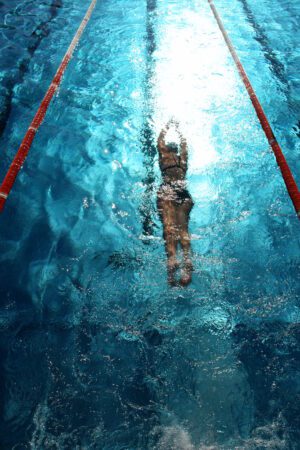T his article discusses the benefits of swimming for exercise and the downsides.
his article discusses the benefits of swimming for exercise and the downsides.
Swimming is often thought of as a leisurely activity, but it can also be an effective form of exercise.
It’s a great way for people of any age and fitness level to improve their cardiovascular health and promote weight loss or maintenance.
Being low-impact, it won’t put pressure on your joints like running or other high-impact sports.
Swimming is excellent for toning muscles and reducing stress.
Regular sessions will build stamina and endurance.
It can help fight depression and enable you to sleep better.
You can get these benefits and more while having fun and spending quality time with your family and friends.
Keep reading to discover more about the benefits of swimming for exercise and for a list of swimming pool safety tips.
Table of Contents
Benefits of Swimming for Exercise
Low-impact –
Exercise doesn’t have to hurt to be effective.
When swimming, the water acts as a cushion for your joints. The water’s buoyancy helps reduce your weight’s impact on your joints and bones.
This makes it an ideal exercise for people with arthritis or other joint problems that high-impact physical activities can aggravate, enabling them to remain physically active.
Individuals recovering from injuries or surgeries who want to get back into shape without undue pain or discomfort may be able to swim for exercise.
NB: If you are recovering from an injury or surgery, check with a medical professional that swimming as exercise will be right for you.
Aids weight loss –
Swimming burns calories, which can help you lose weight or maintain a healthy weight.
You’ll generally burn more calories swimming than walking or biking at the same pace.
For example, if you weigh 155 pounds, you’ll burn about 423 calories swimming laps at a moderate pace for 30 minutes.
According to the American Council on Exercise (ACE), people who swim regularly lose weight more easily than those who don’t swim or choose another form of exercise.
A person weighing 150 pounds who swims slowly for 20 minutes daily can burn 500 calories per week and up to 2,000 calories doing fast laps.
You can also burn calories by doing water aerobics, pool noodle exercises, or even playing in the water.
Improves heart health –
When you swim, your heart rate increases, your breathing becomes deeper and more rhythmic, and your circulation improves.
This helps to strengthen the cardiovascular system and improve overall heart health and function.
By improving cardiovascular function, swimming provides various health benefits that can improve overall fitness and well-being.
Other health benefits –
Swimming can help reduce blood pressure, cholesterol levels, and heart disease risk factors.
Furthermore, it can help lower the risk of type 2 diabetes.
Another of the benefits of swimming for exercise is that it is an excellent workout for the bones, as it is weight-bearing.
It takes more effort to move through water than air. The movements involved will increase your bone density when done regularly.
This makes it an excellent choice for seniors and anyone wanting to prevent osteoporosis as they age.
Improves posture, balance, and stability –
Swimming tones and strengthens the core region (trunk area) more than activities such as walking and cycling.
The core muscles are the ones that support your spine, and they are essential for good posture and balance.
With greater core stability, movements like walking, climbing stairs, and playing sports are more manageable, and the likelihood of injuries reduces with better balance.
Core muscles also play a role in breathing, digestion, and blood circulation.
Strengthens and tones your entire body –
Swimming is a full-body workout that, along with your core, can strengthen and build muscle in your arms, legs, shoulders, neck, and back. 
When you swim, the water provides resistance, making it a great way to build muscular strength.
Open water swimming – swimming in lakes or oceans – will challenge you even further.
Click here for 10 pool noodles exercises that will get you into great shape fast.
NB: Open water swimming can be dangerous. Do not attempt it if you aren’t a strong swimmer. Even then, it’s best not to swim alone.
Boosts endurance –
Swimming involves constant moving for an extended period. Over time, this improves lung function, increasing VO2 max, a measure of how efficiently your body uses oxygen.
Regularly doing laps, aqua aerobics, or other water activities will help you build endurance.
Improves flexibility –
Besides improving your fitness, swimming improves your flexibility.
When you swim, your muscles are gently stretched and worked in a way that they aren’t when you’re doing other kinds of exercise. These movements can help increase your range of motion and even prevent injuries.
So, if you’re looking for a workout that will make you more flexible, swimming is a great option.
Eases stress & boosts mood –
In addition to the physical benefits of swimming as exercise, it can reduce stress and improve mood by lowering cortisol levels (the hormone associated with stress).
Swimming’s rhythmic nature helps calm the mind, while the pressure of the water provides a gentle massage to tense muscles.
This makes it an ideal choice for people who are looking for a relaxing form of exercise.
Moreover, swimming for exercise is a great way to get some fresh air and Vitamin D, which can boost mood and reduce stress.
Promotes better sleep –
Swimming puts you in a meditative state that helps restore calmness. If you’re someone who finds it difficult to wind down before bedtime, try hitting your local pool for some laps—it might just do wonders for your restlessness!
Numerous studies have shown that regular exercise undertaken at a moderate pace can improve sleep quality, with a minimum of 150 minutes per week recommended.
This is partly due to the body’s temperature increasing during exercise. When you finish your workout, your temperature drops to its usual level, signaling your brain that it’s time to sleep.
The Downsides of Swimming for Exercise
You need to know how to swim –
If you don’t know how to swim, you will need to learn before swimming for exercise. You can teach yourself or take lessons.
Check out the “How to Swim” video below for tips.
Access to a pool is required –
If you don’t have a pool or a friend willing to let you use theirs, you will need to use one accesible to the public. In this case, you will need to go in the hours it is open and usually pay an admittance charge.
Weather restrictions –
When swimming in an outdoor pool, bad weather can restrict your workouts
If the pool you use isn’t heated, you probably won’t feel like using it during cold weather.
Potential hair & skin issues
Finally, swimming can dry your skin and hair. A swimming cap can help protect your hair from the damaging effects of chlorine or salt water. I’m currently using the Tripsky Silicone Swim Cap, which is available in 15 different colors. It’s comfortable, suits hair of any length, and doesn’t flatten my hair as some caps I’ve used have.
Goggles can protect sensitive eyes. I like Vorshape Swim Goggles, which are suitable for women, men, and kids. They come in various appealing colors, are comfortable to wear, and provide clear vision.
A body moisturizer can help counteract dry skin. I love Diva stuff Pre-Swim Aqua Therapy Chlorine Neutralizing Body Moisturizing Lotion.
It’s excellent value and comes in a choice of three different scents or unscented.
If swimming outdoors in the sun, apply a waterproof sunscreen with a high SPF to avoid skin cancer.
A video Overview of the Benefits of Swimming for Exercise and the Downsides
Swimming Pool Safety Tips for Swimmers
It goes without saying you should know how to swim before attempting to do it for exercise. 
There are some basic swimming safety tips not specific to swimming for exercise.
For example, children and non-swimmers should be supervised around water.
Inexperienced swimmers should stay in the shallow end of the pool.
It’s also a good idea to learn CPR in case it’s needed in an emergency.
These are basic things.
Below are 10 more swimming pool safety tips to help prevent accidents. By following them, you can stay safe and enjoy your time in the pool.
1. Don’t forget to stay hydrated when swimming for exercise.
2. Never swim alone. There should always be someone else present in case of an emergency.
3. Be aware of your surroundings. Make sure you know where the deep and shallow ends of the pool are.
4. To prevent a potentially catastrophic injury, don’t dive into water without first knowing it is deep enough to do so safely. A depth of at least 9 feet is recommended.
5. Be careful when using pool toys and floats. They can create obstacles in the water and increase the risk of collisions or becoming trapped.
6. Be aware of the weather. If it looks like there might be a thunderstorm, get out of the pool.
7. Never swim under the influence of drugs or alcohol. These can impair your judgment and increase your risk of drowning.
8. If swimming at a public pool, always listen to the lifeguard. They are there to help keep you safe.
9. If you are not a strong swimmer, practice in the shallow end until your skills and confidence improve.
10. If you start to feel dizzy or lightheaded, get out of the pool.
Final Thoughts on Swimming for Exercise
Whether you want to lose weight, gain muscle, or improve your health and fitness, swimming for exercise is a great option.
While it is low in impact compared to many land-based forms of cardio, it potentially provides many of the same benefits as referenced above.
One of the most valuable benefits of swimming as exercise is that because it is low-impact, people of any age and fitness level can do it.
Whether you are just starting or a seasoned athlete, you can find a swimming routine that is right for you.
There are a variety of strokes that you can use to vary your workout and keep your body challenged. And, if you have access to a heated pool, you can swim any time of the year.

